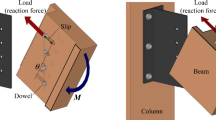Abstract
The bolt–flange fitting and detaching processes are numerically investigated by the updated Lagrangian elastoplastic finite element analysis. The elastoplastic behavior of the flange is modeled by the power-law plastic model with the isotropic strain hardening, while assuming the bolt to be rigid by virtue of the big difference in the material stiffness between bolt and flange. Through the parametric numerical analyses of the bolt–flange fitting and detaching processes with respect to the shape of the bolt cross-section, the characteristics of the bolt fitting and fastening forces are investigated. The validity of the simplified 2-D axisymmetric finite element model is examined through the comparison with the numerical results obtained by 3-D full finite element model. As well, the effects of the bolt petal number on these forces are investigated, and the experiment is performed to verify the numerical simulation.
Similar content being viewed by others
References
Cho JR, Song JI, Noh KT, Jeon DH (2005) Nonlinear finite element analysis of swaging process for automobile power steering hose. J Mater Process Technol 170:50–57
Hassan NK, Mohamedien MA, Rizkalla SH (1996) Finite element analysis of bolted connections for PFRP composites. Compos Part B 27B:339–349
Izumi S, Yokoyama T, Iwasaki A, Sakai S (2005) Three-dimensional finite element analysis of tightening and loosing mechanism of threaded fastener. Engng Failure Anal 12:604–615
Razabi H, Abolmaali A, Ghassemieh M (2007) Invisible elastic bolt model concept for finite element analysis of bolted connections. J Mater Process Technol 63:647–657
Griza S, Bertoni F, Zanon G, Reguly A, Strohaecker TR (2009) Fatigue in engine connecting rod bolt due to forming lags. Engng Failure Anal 16:1542–1548
Liao RD, Sun YJ, Liu JX, Zhang WZ (2011) Applicability of damage models for failure analysis of threaded bolts. Engng Fract Mech 78(3):514–524
Sase N, Nishioka K, Koga S, Fujii H (1998) An anti-loosing screw-fastener innovation and its evaluation. J Mater Process Technol 77:209–215
Kober M, Kühhorn A (2010) Development of optimized washer-shape for damage-free load application to composites. Composite Struct 92:1985–1991
Kobayashi S, Oh SI, Altan T (1989) Metal forming and the finite element method. Oxford University Press, Oxford
Belytschko T, Liu WK, Moran B (2000) Nonlinear finite elements for continua and structures. Wiley, Singapore
Malvern LE (1969) Introduction to the mechanics of a continuous media. Prentice-Hall, Singapore
Ray SK, Utku S (1989) A numerical model for the thermo-elastoplastic behavior of a material. Int J Numer Methods Engng 28:1103–1114
Huang YM, Leu DK (1995) An elasto-plastic finite element analysis of sheet metal U-bending process. J Mater Process Technol 48:151–157
Cho JR, Ha DY (2001) Thermo-elastoplastic characteristics of heat-resisting functionally graded composite materials. Struct Eng Mech 11(1):49–70
Zienkiewicz OC, Taylor RL (1991) The finite element method, vol 2. McGraw-Hill, Singapore
Xing HL, Wang CW, Zhang KF, Wang ZR (2004) Recent development in the mechanics of superplasticity and its applications. J Mater Process Technol 151(1–3):196–202
Cho JR, Park HJ (2003) Effective volume fraction optimization for thermal stress reduction in FGMs using irregular h-refinement. Int J Numer Methods Engng 58:749–770
Author information
Authors and Affiliations
Corresponding author
Rights and permissions
About this article
Cite this article
Cho, J.R., Lee, D.Y., Yoo, W.S. et al. Numerical investigation of bolt fitting and fastening forces by elastoplastic finite element analysis. Int J Adv Manuf Technol 66, 71–81 (2013). https://doi.org/10.1007/s00170-012-4306-x
Received:
Accepted:
Published:
Issue Date:
DOI: https://doi.org/10.1007/s00170-012-4306-x




